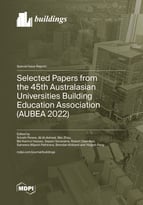Selected Papers from the 45th Australasian Universities Building Education Association (AUBEA 2022)
A special issue of Buildings (ISSN 2075-5309). This special issue belongs to the section "Construction Management, and Computers & Digitization".
Deadline for manuscript submissions: closed (30 April 2023) | Viewed by 27098
Special Issue Editors
Interests: construction informatics; blockchain, IoT and digital twins; artificial intelligence techniques; construction management; embodied carbon estimating; project management; public-private partnerships; construction data analytics; disaster management; economics of sustainability; risk management; circular economy; offsite construction
Special Issues, Collections and Topics in MDPI journals
Interests: international construction; project management; sustainable construction
Interests: BIM implementation; computer vision; digital construction; digital twin
Special Issues, Collections and Topics in MDPI journals
Interests: fire engineering; steel–concrete composite technology; sustainable building materials; finite element modelling
Special Issues, Collections and Topics in MDPI journals
Interests: knowledge management; construction/project management; sustainability; smart modern construction
Special Issues, Collections and Topics in MDPI journals
Interests: construction health and safety; project finance; public–private partnership; smart construction; sustainability
Special Issues, Collections and Topics in MDPI journals
Interests: built environment; fire safety; construction management; composite structures
Interests: construction materials; construction technology; steel construction; structural engineering
Interests: BIM application in WHS; procurement and sustainability; construction safety and health management; human behaviour in built environment; organisational culture and behaviours; robotics in construction; sustainable procurement
Special Issues, Collections and Topics in MDPI journals
Special Issue Information
Dear Colleagues,
The 45th Australasian Universities Building Education Association (AUBEA) conference was hosted by Western Sydney University, Kingswood Campus, Sydney, Australia by the School of Engineering, Design, and Built Environment in collaboration with the Centre for Smart Modern Construction, Western Sydney University, between 23rd and 25th November 2022. The conference presented the latest research with the theme of “Global Challenges in a Disrupted World: Smart, Sustainable and Resilient Approaches in the Built Environment.” AUBEA 2022 brought together researchers, educators, students, and industry practitioners from Australia and other regions to share knowledge, collaborate, reflect, and learn about current issues and participate in shaping the future of the construction and built environment sectors.
The conference presented the latest research on a wide range of topics related to “Smart, Sustainable and Resilient Approaches in the Built Environment”; the research proceedings were split into eight sub-themes. The key research areas discussed include construction project management, the digitalisation of construction, industrialisation, sustainability, resilience, health and safety, and education in the built environment.
Selected authors from the AUBEA 2022 are invited to submit their extended papers to this Special Issue, which will be fully peer reviewed for further selection and publication.
Prof. Dr. Srinath Perera
Dr. Ali Al-Ashwal
Dr. Wei Zhou
Dr. Md Kamrul Hassan
Dr. Sepani Senaratne
Dr. Robert Osei-Kyei
Dr. Sameera Wijesiri Pathirana
Dr. Brendan Kirkland
Dr. Yingbin Feng
Guest Editors
Manuscript Submission Information
Manuscripts should be submitted online at www.mdpi.com by registering and logging in to this website. Once you are registered, click here to go to the submission form. Manuscripts can be submitted until the deadline. All submissions that pass pre-check are peer-reviewed. Accepted papers will be published continuously in the journal (as soon as accepted) and will be listed together on the special issue website. Research articles, review articles as well as short communications are invited. For planned papers, a title and short abstract (about 100 words) can be sent to the Editorial Office for announcement on this website.
Submitted manuscripts should not have been published previously, nor be under consideration for publication elsewhere (except conference proceedings papers). All manuscripts are thoroughly refereed through a single-blind peer-review process. A guide for authors and other relevant information for submission of manuscripts is available on the Instructions for Authors page. Buildings is an international peer-reviewed open access monthly journal published by MDPI.
Please visit the Instructions for Authors page before submitting a manuscript. The Article Processing Charge (APC) for publication in this open access journal is 2600 CHF (Swiss Francs). Submitted papers should be well formatted and use good English. Authors may use MDPI's English editing service prior to publication or during author revisions.
Keywords
- digitalisation
- health and safety
- construction
- project management
- resilience
- industrialisation
- sustainability














